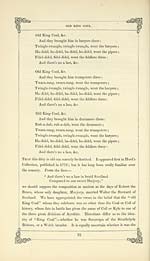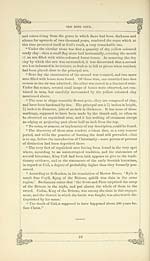Glen Collection of printed music > Printed text > Ballads and songs of Ayrshire > Volume 1
(29) Page 23
Download files
Complete book:
Complete section:
Individual page:
Thumbnail gallery: Grid view | List view

OLD KING COUL.
Scots or Picts, or both, by whom he was defeated ; but that a battle was
fought, and a person of distinction buried, at the spot mentioned by our
ancient writers — which still bears the name of Coilsfield — is placed beyond
all question by the recent opening of the tumulus. The following account
of this interesting operation was communicated to the local journals at
the time by one of the antiquarian gentlemen who took part in it : —
"discoveet of sepci-chral ukns in the grave of king coil.
" To the south of Coilsfield House, in Ayrshire, and immediately west
of the farm offices, is a circular mound, enclosed by a large hedge and
planted with oak and other trees. On the centre and highest part of this
mound, are two large stones, masses of basalt — which, according to tra-
dition, mark the spot Avhere the mortal remains of Old King Coil were
deposited. The names borne by places in the vicinity are in keeping
with this tradition. The beautiful mansion adjoining, one of the seats of
the Earl of Eglinton, is named Coilsfield, i.e., the field of Coil. Kyle,
the name of the central district of Ayrshire, is supposed to be the same
word Coil spelled in accordance with the vulgar pronunciation of the
name. A little brook that empties itself into the Fail is called ' The
Bloody-burn,' and so testifies by its name, of the blood by which its
Avaters had, on some memorable occasion, been polluted ; and a flat al-
luvial piece of ground along the Fail, opposite the mouth of the bloody
burn, is still called 'The Dead-men 's-holm,' probably from its having
been the burial place of the warriors. It is true that a high authority —
Chalmers, author of the Caledonia, denies that there ever was such a
person as King Coil. Although it is well known that that author at times
allows himself to be carried away by an undue love of theory, still his
scepticism has had the efi'ect of degrading into mere fable, in the estima-
tion of many, traditionary history, in regard to the West of Scotland.
" Regard, therefore, for traditionary evidence, respect for the mighty
dead, and love of historical truth combined to render it desirable that
Coil's grave should be opened.
" Accordingly, on the evening of the 29th May, 1837, in presence of
several gentlemen, the two large stones were removed. The centre of
the mound ivas found to be occupied by boulder stones, some of them of
considerable size. When the excavators had reached the depth of about
four feet, they came on a flag stone of a circular form of about three feet in
diameter. The light had now failed, and rain began to fall in torrents — ■
but the interest excited was too intense to admit of any delay; candles
were procured, all earth and rubbish cleared away, and the circular stone
carefully lifted up.
" The seclusion of the spot, the beauty of the surrounding lawn and
trees, the eager countenances of the spectators, and above all, the light
Scots or Picts, or both, by whom he was defeated ; but that a battle was
fought, and a person of distinction buried, at the spot mentioned by our
ancient writers — which still bears the name of Coilsfield — is placed beyond
all question by the recent opening of the tumulus. The following account
of this interesting operation was communicated to the local journals at
the time by one of the antiquarian gentlemen who took part in it : —
"discoveet of sepci-chral ukns in the grave of king coil.
" To the south of Coilsfield House, in Ayrshire, and immediately west
of the farm offices, is a circular mound, enclosed by a large hedge and
planted with oak and other trees. On the centre and highest part of this
mound, are two large stones, masses of basalt — which, according to tra-
dition, mark the spot Avhere the mortal remains of Old King Coil were
deposited. The names borne by places in the vicinity are in keeping
with this tradition. The beautiful mansion adjoining, one of the seats of
the Earl of Eglinton, is named Coilsfield, i.e., the field of Coil. Kyle,
the name of the central district of Ayrshire, is supposed to be the same
word Coil spelled in accordance with the vulgar pronunciation of the
name. A little brook that empties itself into the Fail is called ' The
Bloody-burn,' and so testifies by its name, of the blood by which its
Avaters had, on some memorable occasion, been polluted ; and a flat al-
luvial piece of ground along the Fail, opposite the mouth of the bloody
burn, is still called 'The Dead-men 's-holm,' probably from its having
been the burial place of the warriors. It is true that a high authority —
Chalmers, author of the Caledonia, denies that there ever was such a
person as King Coil. Although it is well known that that author at times
allows himself to be carried away by an undue love of theory, still his
scepticism has had the efi'ect of degrading into mere fable, in the estima-
tion of many, traditionary history, in regard to the West of Scotland.
" Regard, therefore, for traditionary evidence, respect for the mighty
dead, and love of historical truth combined to render it desirable that
Coil's grave should be opened.
" Accordingly, on the evening of the 29th May, 1837, in presence of
several gentlemen, the two large stones were removed. The centre of
the mound ivas found to be occupied by boulder stones, some of them of
considerable size. When the excavators had reached the depth of about
four feet, they came on a flag stone of a circular form of about three feet in
diameter. The light had now failed, and rain began to fall in torrents — ■
but the interest excited was too intense to admit of any delay; candles
were procured, all earth and rubbish cleared away, and the circular stone
carefully lifted up.
" The seclusion of the spot, the beauty of the surrounding lawn and
trees, the eager countenances of the spectators, and above all, the light
Set display mode to: Large image | Transcription
Images and transcriptions on this page, including medium image downloads, may be used under the Creative Commons Attribution 4.0 International Licence unless otherwise stated. ![]()
| Special collections of printed music > Glen Collection of printed music > Printed text > Ballads and songs of Ayrshire > Volume 1 > (29) Page 23 |
|---|
| Permanent URL | https://digital.nls.uk/91252578 |
|---|
| Shelfmark | Glen.205(1) |
|---|---|
| Additional NLS resources: | |
| Description | Illustrated with sketches, historical, traditional, narrative and biographical |
|---|---|
| Shelfmark | Glen.205(1-2) |
| Additional NLS resources: | |
| Attribution and copyright: |
|
| Description | Scottish songs and music of the 18th and early 19th centuries, including music for the Highland bagpipe. These are selected items from the collection of John Glen (1833 to 1904). Also includes a few manuscripts, some treatises, and other books on the subject. |
|---|
| Description | The Glen Collection and the Inglis Collection represent mainly 18th and 19th century Scottish music, including Scottish songs. The collections of Berlioz and Verdi collected by bibliographer Cecil Hopkinson contain contemporary and later editions of the works of the two composers Berlioz and Verdi. |
|---|

